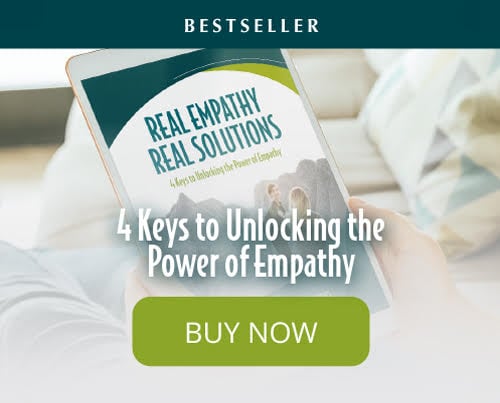Have you ever found yourself snapping at someone, only to instantly regret it? Or struggled to understand why a close friend acted insensitive when you were hoping for emotional support? These experiences often stem from what’s called the empathy gap—an impediment that hinders the understanding between people, and even within ourselves.
Do you know how to bridge this gap in your relationships? Many people don’t!
Estimated reading time: 5 minutes

In my emotional intelligence training and client coaching, I regularly observe the ripple effects of the empathy gap in marriages, parenting, friendships, and the workplace.
The result?
Unnecessary misunderstanding, disconnection, resentment, hurt, and missed opportunities for connection.
The good news?
Neuroscience reveals that empathy is highly teachable, and can therefore be learned.
Studies from the University of California, Berkeley, and research by Daniel Goleman, author of Emotional Intelligence, suggest that empathy can be strengthened through practice and mindfulness.
This article will cover what the empathy gap is, why it happens, and actionable steps to close the gap, empowering you to build healthier, more connected relationships in every area of life.
What Is the Empathy Gap?
Before we can close the empathy gap, we need to understand it.
One of the most striking aspects of empathy research is the hot-cold empathy gap. This bias explains why our decisions and judgments shift dramatically depending on our emotional state—something we all experience but often fail to recognize.
The empathy gap is a well-documented psychological bias, in which individuals struggle to understand or predict the emotions and behaviors of others—or their future selves—when experiencing different emotional states.
Coined by behavioral economist George Loewenstein, this concept is detailed in his 2005 study “Hot–Cold Empathy Gaps and Medical Decision Making” published in Health Psychology, where he demonstrates how alternating emotional states significantly distort our ability to predict and understand feelings across time and between ourselves and others.
Everyday Examples of the Hot-Cold Empathy Gap
It’s often helpful to use examples to help illustrate concepts, such as a hot-cold empathy gap. Here are a few:
- A low-key, more logical parent may too quickly dismiss a child's emotional distress as “misbehaving,” forgetting their emotional expression is natural and they lack self-control developed over many years.
- A partner feeling happy with their accomplishments at work may minimize the significance or the still-stinging hurt of their spouse from an intense argument they had the day before.
- An overwhelmed leader may misinterpret a team member’s quietness as disengagement or lack of dedication to the company, or a manager may lapse and forget their empathetic goals during high-pressure deadlines.
Scientific experiments reveal how people make drastically different decisions when in “hot” states (stressed, angry, hungry) versus “cold” states (calm, relaxed). Loewenstein's research illustrates how individuals underestimate cravings, anger, or pain when in neutral moods.
Recognizing this tendency is the first step toward improving your ability to empathize and up-level emotional intelligence.
Deep Dive: “The Three Kinds of Empathy: Cognitive, Emotional, and Compassionate.”
Why Moods Warp Your Perspective and 3 Reasons Why the Empathy Gap Happens
Exploring why empathy gaps occur is key to overcoming them. Multiple psychological and societal factors make bridging empathy gaps more challenging, but it’s entirely possible when you build self-awareness and exercise mindful responses.
Here are three common reasons why gaps happen in our interactions with others.
Reason #1: Emotional States Create Blind Spots
Decades of cognitive psychology research show that emotions can skew our perceptions.
According to the American Psychological Association, a “cold state” refers to a calm, emotionally neutral condition in which individuals feel balanced, logical, and relatively unaffected by strong emotions such as anger, fear, or desire. At such times, people often take pride in being rational decision-makers.
However, research shows that this rationality can come with a cost: a “blind spot” in predicting how intense emotional states (hot states) will influence future behaviors and decisions.
For example, in a cold state, you might believe you'll remain patient during your child's tantrum or stay disciplined with your health goals. Yet, once you're in a “hot state”—angry, stressed, or overwhelmed—your capacity for patience or discipline often diminishes.
This mismatch is a hot-cold empathy gap. People in cold states struggle to empathize with their future, more emotional selves. And their cold states can also color their responses to others’ hot states.
These emotional states lead to an overconfidence in one’s emotional control and underestimation of the impact of situational or environmental triggers.
Recognizing when you're in a cold state and accounting for emotional variability can help mitigate blind spots, improve effectiveness, and enable you to better empathize with others.
For example, when my daughter was young, she came home from school upset over a situation that happened with a friend. When I responded lovingly yet calmly, she misread my calmness as “not caring.” This exchange taught me that matching a person’s emotional intensity is key to effective empathy. It creates resonance that is profoundly helps another person feel understood.
Quick Self-Check
Next time you’re about to respond to a person or make a decision, pause and ask yourself: “Am I in a hot or cold state?”
This simple internal audit can improve decision-making, emotional modulation, and strengthen empathy in relationships.
Reason #2: Fast-Paced Modern Life Limits Self-Reflection
Modern life is designed for speed and efficiency. However, relationships are anything but efficient and emotional intelligence is hard-earned. They both require patience, understanding and presence.
When we are focused on efficiency and productivity, our brain’s bandwidth for expressing empathy is reduced. However, if we are in a hot state, i.e., angry, while also focused on checking things off our list, it can be even harder to empathize.
For instance, I once coached a C-Suite leader of a large company whose main priority was high productivity—he knew how to get things done and highly valued it. However, when he was in a heated state, his heightened emotions overrode even the slightest ability to empathize with employees, often resulting in unnecessary harshness and misunderstandings in communication.
A study published in Frontiers in Psychology highlights how chronic busyness and time pressures impair reflective thinking and lower helpful prosocial behaviors, such as empathy. These constraints make it harder to tune into our own or others’ emotional states.
Reason #3: Technology Diverts Us from Self-Awareness
While technology connects us globally, over-reliance on it can weaken our empathy muscles.
Research from the University of Michigan found a 40% decline in empathy among college students since the 1980s, primarily attributed to the rise in digital communication and a corresponding decrease in face-to-face interactions.
By recognizing these contributing factors, you can take intentional steps to reduce their impact and exercise mindful empathy daily.
3 Research-Backed Ways to Overcome the Empathy Gap
Now that you have a basic understanding of the empathy gap, let’s apply practical strategies to bridge this gap with self-awareness, emotional regulation, and understanding. Each method is supported by research and designed to build deeper connections.
 Pause Before Reacting
Pause Before Reacting
Neuroscience shows that a brief pause allows our brain’s prefrontal cortex—the center for rational thinking—to regain control over the reactive amygdala. Harvard Business Review promotes breathing as a way to reduce stress, increase resilience, and promote calmness. Numerous studies indicate that individuals who employ a simple breathing pause exhibit lower reactions, reduced conflicts, and improved self-regulation.
Quick Exercise:
When your child has a tantrum or your employee fails to meet standards or goals, take three deep, slow breaths and bring to mind three qualities (one per breath) that you appreciate about your child or employee. This tiny shift signals the brain to calm and creates space to empathize with their struggle before reacting or correcting behavior.
 Practice Self-Regulation—a Vital Foundation for Empathy
Practice Self-Regulation—a Vital Foundation for Empathy
In our social lives, responding with empathy often relies on two linked EQ abilities: 1) managing our own emotions and 2) responding to the emotions of others.
Research published in the journal Affective Science explored how different types of empathy affect a person’s ability to regulate their emotions. The study found that cognitive empathy—the ability to understand what someone else is feeling from a thoughtful, mental perspective—helps people manage their own emotional reactions more effectively.
In contrast, affective or emotional empathy—actually feeling what someone else is feeling—can sometimes make emotional control harder, especially when the emotions are strong or overwhelming.
In your everyday life, if you can take a step back and try to mentally understand others (rather than emotionally absorb everything), you’ll be better equipped to stay calm and respond constructively in intense emotional interactions.
For someone looking to close the empathy gap—like reacting less harshly during arguments—the above research suggests that empathy works best when combined with emotional self-regulation. Practicing techniques like deep breathing or reframing the situation can help you stay grounded, so you can show compassion without losing yourself in the heat of the moment.
For instance, in a relationship argument, instead of engaging in a hot state, such as anger or frustration, take time to self-calm and emotionally regulate yourself. Then, revisit the situation with the other person once you’re calm. This EQ skill reduces harsh words and promotes compassionate dialogue.
Deep dive: “Why Should You Care About Emotional Regulation?”
 Label to Diffuse Intense (Hot) Emotions
Label to Diffuse Intense (Hot) Emotions
Labeling emotions activates the prefrontal cortex (the logical part of our brains), reducing the intensity of negative feelings, according to research. Naming feelings boosts emotional clarity and soothes our emotions.
When you put a name to what you are feeling—for example, saying internally or aloud, "I’m feeling angry," or “I feel stressed,” or “I am feeling anxious”—you trigger activity in the right prefrontal cortex, a brain region associated with self-control and regulation. This activation exerts a calming influence by dampening activity in the amygdala, the brain’s emotional alarm system.
Pretty great payoff!
It also works when responding to others.
For example, as a parent, help your child develop emotionally by simply labeling their emotions, such as saying, “You’re upset because the toy broke,” or “Wow, you sound really hurt about your friend’s remark.” These simple validations enhance emotional regulation and resilience while also calming hot emotional states.
In the workplace, this feedback loop might look like a manager saying to their employee, “You look frustrated with your co-worker.” Or “That tight timeline was stressful and you seem taxed right now. I really appreciate your focused efforts—go take a 20-minute break.”
In a landmark UCLA brain-imaging study, researchers found that participants viewing angry or fearful facial expressions experienced less intense emotional activation in their amygdala when they labeled the emotion in the image, compared to tasks where they didn't label it.
This labeling process—also known as affect labeling—works even if you don’t consciously try to feel better; simply naming the emotion appears to serve as an implicit form of emotion regulation.
Over time, regular practice of labeling emotions helps reduce emotional reactivity and supports emotional clarity. You can help yourself and the other person by pausing and clarifying what’s happening beneath the surface. This seemingly small act will develop greater empathetic communication as well as enable you to stay calmer yourself.
Make it a practice.
Then, turn that practice into a habit!
| CONCEPT | WHAT IT MEANS | HOW IT HELPS | TRY THIS |
| Hot-cold empathy gap | We misjudge how we’ll think or feel in future emotional states (e.g., calm vs. stressed). | Recognizing this gap helps us pause and better understand our experience and others' reactions. | Before reacting, ask, "How would I respond if I weren’t upset or stressed?" |
| Emotional Forecasting | Visualizing future emotions helps us make more thoughtful, less impulsive choices. | By imagining our own. and others' feelings, we heighten perspective-taking and compassion. | Picture how the other person will feel tomorrow based on your actions today. |
| Labeling Emotions | Naming emotions reduces emotional intensity and increases emotional clarity. | Labeling emotions—ours' and others’—creates space for empathy instead of reactivity. | Use phrases such as, "I feel angry" or "You seem frustrated" to build greater understanding increase responsiveness. |
The Transformative Benefits of Closing the Empathy Gap
Closing the empathy gap isn’t just good for your relationships—it transforms your overall well-being.
A meta-analysis has found that empathy is correlated with greater relationship satisfaction, lower stress, and improved mental health outcomes.
By actively closing empathy gaps, you’ll experience:
- Stronger, more harmonious relationships
- Greater emotional resilience and patience
- Higher overall life satisfaction and peace of mind
At Heartmanity, we’ve seen firsthand how empathy empowers people to create positive change in every aspect of their lives.
Empathy Is a Lifelong Skill!
Empathy isn’t a band-aid or a quick fix for our relationships. It grows more powerful with attention and practice.
Decades of research confirm what we at Heartmanity teach daily: with mindful effort, anyone can learn to bridge empathy gaps and create deeper, healthier connections.
Your journey to closing the empathy gap begins with awareness, followed by making daily, small choices that exercise empathy.
Ready to take the next step?
Frequently Asked Questions
What causes an empathy gap?
Empathy gaps occur when people are in different emotional states, leading to cognitive blind spots where they misjudge or misunderstand emotions—their own or others’. Contributing factors include emotional arousal, stress, and limited self-awareness.
How do you fix the empathy gap in relationships?
Practical strategies like pausing before reacting, practicing active listening, using emotional forecasting, and labeling emotions can significantly reduce empathy gaps and foster healthier, more empathetic relationships.
Is empathy a skill you can develop?
Yes! Numerous studies in neuroscience and psychology confirm that empathy is a trainable skill. Through practice, reflection, and intentional strategies, empathy can flourish at any age.
Can you teach empathy to children?
Absolutely. Children learn empathy best through modeling, emotion labeling, validating feelings, and experiencing consistent, compassionate communication in their environment.
For a deep dive, see our articles, “How to Teach to Children and Create Understanding” and “Teach Empathy to Kids the Easy Way.”
To learn and master empathy...












